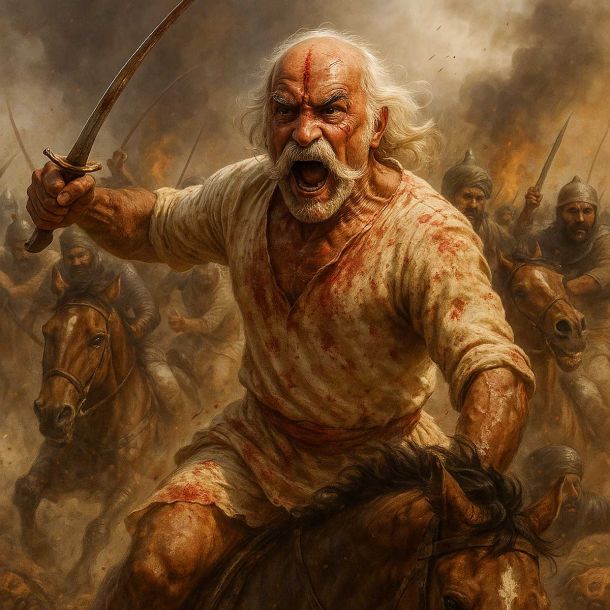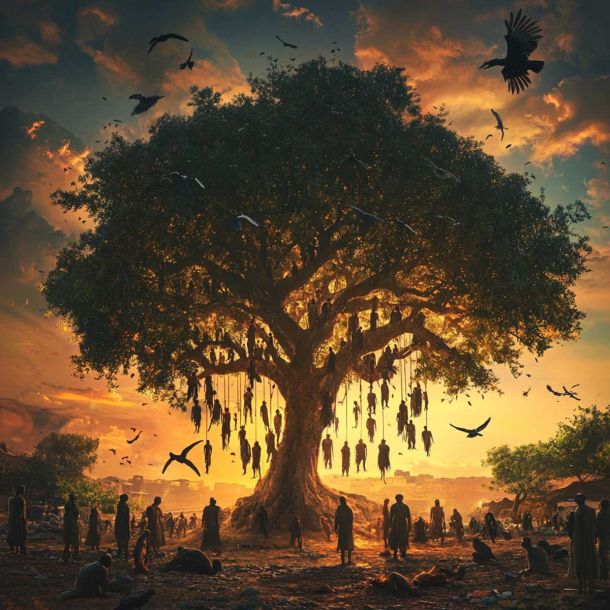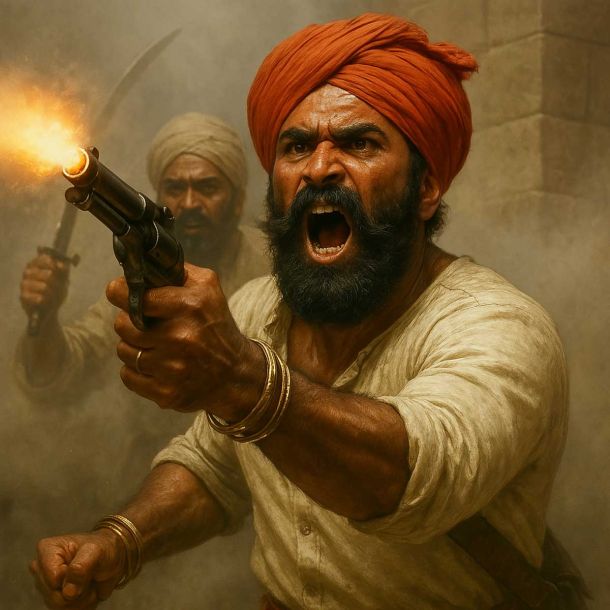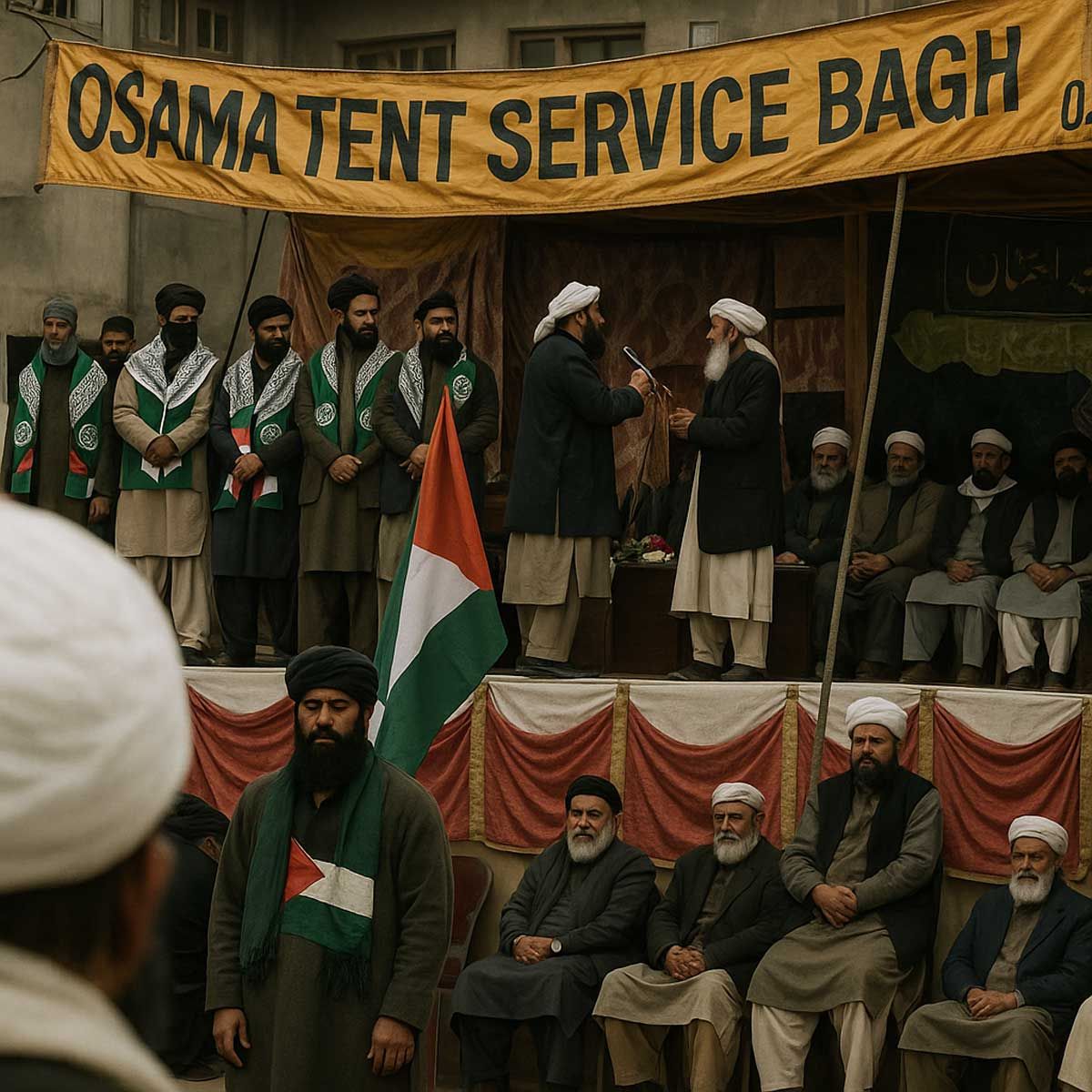Sanatan Articles
Satyaagrah
Written on
Satyaagrah
Written on
Satyaagrah
Written on
Satyaagrah
Written on
Satyaagrah
Written on
JOIN SATYAAGRAH SOCIAL MEDIA
From the battlegrounds of WWII to becoming an INA soldier and then to the Indian cinema, Nazir Hussain's journey is a testimony to talent and tenacity, a mainstay in Hindi films and the pioneering force behind Bhojpuri cinema, his legacy remains unmatched

Nazir Hussain, a name synonymous with Hindi cinema, has been an emblematic figure for over three decades. His benign visage made him the quintessential embodiment of the paternal archetype. By his 50s, Hussain had carved out a unique niche for himself. He became the singular actor with the privilege of portraying the father or father-in-law of cinematic icons like Dilip Kumar, Raj Kapoor, Dev Anand, and others like Shammi Kapoor, Dharmendra, not to mention heroines spanning from Meena Kumari to Hema Malini.
|
However, limiting Hussain to the role of a father figure would be doing him a disservice. In his expansive career, spanning over 400 films, he showcased a breathtaking range of characters. Whether it was the hapless Gurcharandas from "Parineeta" (1953), the imposing Lala Daulatram Khanna of "New Delhi" (1956), the irate Mr. Khanna from "Leader" (1964), or the disheartened Gen. Durgaprasad Bakshi from "Prem Pujari" (1970), Hussain brought each character to life with unparalleled conviction.
His versatility was further demonstrated through a spectrum of roles. His commanding physical stature, candid demeanor, and the ability to seamlessly oscillate between worldly wisdom and stark authority made him a force to be reckoned with. Whether he was depicting the everyday struggles of rickshaw-pullers and village postmasters or the elite lives of affluent landlords and tycoons, Nazir Hussain portrayed each character with the same fervor and grace.
|
Nazir Hussain, apart from his indelible mark in the cinematic world, had an aura that seemed fitting for authoritative roles. Often cast as police officials, he delivered memorable performances as the Police Superintendent in “Ganga Jumna” (1961) and the Commissioner of Police in “Jewel Thief” (1967). His portrayals extended to the disciplined world of the military, exemplified by his role as Colonel Choudhury in “Lalkar” (1972). Yet, Hussain's range was not confined to just these; he brilliantly depicted religious figures, particularly Catholic priests. Many recall his heartwarming portrayal as Father Gonsalves in “Amar Akbar Anthony” (1977), where he played Amitabh Bachchan's foster father, and as Father Joseph in “Sharmeelee” (1970).
This aptitude to embrace such diverse roles was deeply rooted in his personal history — a tapestry of rich experiences. It's essential, however, to differentiate between Nazir Hussain, the actor, and filmmaker Nasir Hussain, known for modern Indian musicals and being Aamir Khan's uncle.
Nazir Hussain's story began in 1922, in the quaint village of Usia, located in Ghazipur district of what was known as the United Provinces. Born to Shahabzad Khan, a railway guard, young Nazir initially followed in his father's footsteps, joining the railways as a fireman. However, the tumult of World War II changed the trajectory of his life. Hussain enlisted in the British Indian Army, leading him to Southeast Asia. Fate took a twist when he was taken as a prisoner of war by the Japanese. But in adversity, inspiration dawned. At the camp, the charismatic Netaji Subhas Chandra Bose left an indelible mark on Hussain, compelling him to join the ranks of the Indian National Army. The actor's life, thus, was as layered and compelling as the myriad characters he portrayed on screen.
Post his stint with the INA, Nazir Hussain, like many of his comrades, faced challenges in civilian life. With an unremarkable war record, his association with the INA was a double-edged sword. While it brought him admiration from certain quarters, it also created obstacles, particularly in his professional life. The army was no longer an option, and finding a steady job turned out to be an uphill task. However, in time, he earned the recognition as a freedom fighter, a title that granted him certain privileges, including free railway travel.
Destiny, as it seems, had other plans for Hussain. He was gently nudged into the world of theatre, taking on minor roles. This seemingly incidental foray turned fortuitous when the renowned B.N. Sircar took notice of his talents. Invited to join the reputed New Theatres in Calcutta, Hussain found himself amidst a whirlwind of creativity and cinematic brilliance. It was here that he crossed paths with the iconic filmmaker, Bimal Roy.
Their meeting was serendipitous. Roy, captivated by Hussain's real-life INA background, saw an opportunity to bring a compelling narrative to the big screen. Their collaboration birthed the film “Pehla Aadmi” (1950), a poignant depiction of love amidst the turbulence of World War II and the emergence of the INA. While information on this film remains scanty, its significance cannot be understated. Not only is it believed to be the first cinematic representation of Netaji, but Hussain also showcased his multifaceted talent by contributing to its screenplay and dialogues. It is a testament to his journey from the battlegrounds of Southeast Asia to the spotlight of Indian cinema.
|
Nazir Hussain's association with the esteemed Bimal Roy was not fleeting. This prolific partnership saw Hussain grace the screen in several of Roy's classics. From playing the compassionate rickshaw-puller in "Do Bigha Zamin" who extends a guiding hand to Balraj Sahni, to exploring the dark recesses of human emotion as a cunning villain in "Yahudi," Hussain's versatility was evident. Not to forget his commendable role in “Parakh” (1960), a film that, despite not being a mainstream success, painted a keen portrait of Indian politics.
But Hussain's cinematic journey was not restricted to Bimal Roy's vision. He proved to be a coveted asset for a gamut of eminent directors. B.R. Chopra's “Naya Daur” (1957) and “The Burning Train” (1980) saw him shine, as did Hrishikesh Mukherjee's films like "Musafir" and "Anuradha." The list doesn't end there. With directors such as Raj Khosla, Guru Dutt, Shakti Samanta, Ramanand Sagar, Asit Sen, and Feroz Khan, Hussain traversed diverse cinematic landscapes.
From the romantic backdrop of "Kashmir ki Kali" to the thrilling espionage in "Aankhen," to even the memorable "Amar, Akbar, Anthony" under Manmohan Desai's direction, Hussain was seemingly everywhere. His ability to mould himself to fit any role, be it a supportive figure, a villain, or a poignant character, speaks volumes of his unparalleled talent. Each film, each role, further cemented his stature as an irreplaceable gem of the silver screen.
|
The Godfather of Bhojpuri Cinema: Nazir Hussain's Undying Legacy
While many remember Nazir Hussain for his omnipresence in Hindi films, few are aware of his instrumental role in ushering Bhojpuri cinema into prominence. Often regarded as the godfather of Bhojpuri films, his influence on the industry is simply unparalleled.
The seed was sown during a serendipitous encounter with India's first President, Rajendra Prasad. While engaging in a conversation, buoyed by their shared linguistic bond, Prasad ignited in Hussain a passion for Bhojpuri cinema. Urging him to explore this untapped genre, Prasad probably didn't realize then that he was shaping the destiny of an entire film industry.
True to his commitment, Hussain crafted “Ganga Maiyya Tohe Piyari Chadhaibo” in 1963. Not just another film, this was a watershed moment for Bhojpuri cinema – marking its debut on the Indian cinematic landscape. Written by Hussain himself and seeing him don an important character role, this film was the commencement of a revolution. It wasn't just about introducing a regional language to the big screen; it was about capturing the essence, culture, and issues of the Bhojpuri-speaking populace. These films didn't merely offer rustic entertainment; they delved deep into societal themes, reflecting the lives and struggles of those they represented.
|
Nazir Hussain's dedication to Bhojpuri cinema wasn't just a professional venture, but a labor of love. A love that has, over the years, carved a niche for Bhojpuri films and ensured their place in the annals of Indian cinema.
As the winds of change swept through Indian cinema in the 1970s, with action-packed storylines becoming the new norm, Nazir Hussain proved yet again his unwavering commitment to the craft. It was during this dynamic era that he breathed fresh life into Bhojpuri cinema with the hit "Balam Pardesia" in 1979, reaffirming his title as the guardian angel of the industry.
However, with the dawn of the 1980s, there was a perceptible slowing down in Hussain's cinematic journey. One of his final notable performances was in B.R. Chopra's "Mazdoor" in 1983. Though he graced the silver screen for the last time in K. Asif’s much-delayed "Love and God" in 1986, the movie itself remained incomplete, an unintentional metaphor for the abrupt end of his illustrious career.
In October 1987, the lights dimmed as Nazir Hussain took his final bow, leaving the world at the age of 65. The end of his journey, however, was not the end of his legacy. With a career spanning several decades, where he shared screen space with almost every prominent name of his time, Hussain's contributions to cinema remain unparalleled and will forever resonate in the annals of Indian film history.
|
 Support Us
Support Us
Satyagraha was born from the heart of our land, with an undying aim to unveil the true essence of Bharat. It seeks to illuminate the hidden tales of our valiant freedom fighters and the rich chronicles that haven't yet sung their complete melody in the mainstream.
While platforms like NDTV and 'The Wire' effortlessly garner funds under the banner of safeguarding democracy, we at Satyagraha walk a different path. Our strength and resonance come from you. In this journey to weave a stronger Bharat, every little contribution amplifies our voice. Let's come together, contribute as you can, and champion the true spirit of our nation.
 |  |  |
| ICICI Bank of Satyaagrah | Razorpay Bank of Satyaagrah | PayPal Bank of Satyaagrah - For International Payments |
If all above doesn't work, then try the LINK below:
Please share the article on other platforms
DISCLAIMER: The author is solely responsible for the views expressed in this article. The author carries the responsibility for citing and/or licensing of images utilized within the text. The website also frequently uses non-commercial images for representational purposes only in line with the article. We are not responsible for the authenticity of such images. If some images have a copyright issue, we request the person/entity to contact us at This email address is being protected from spambots. You need JavaScript enabled to view it. and we will take the necessary actions to resolve the issue.
Related Articles
- Saraswathi Rajamani, at 16, became the youngest and first female spy for INA, boldly recruited by Netaji in 1942, courageously spent two years spying on the British in Myanmar during WWII, a pivotal yet overlooked heroine in India's struggle for freedom
- Birth, Parentage and Early Environment - An Indian Pilgrim (Netaji's Life and writings)
- Debunking the myth of "De Di humein Aazadi Bina Khadag Bina Dhal": Bharat’s founding story bestows upon it an extravagant national philosophy and long-lasting costs
- In a historical move ahead of Republic Day on January 26th, the Amar Jawan Jyoti flame at the India Gate would be merged with the flame at the National War Memorial on Friday
- Netaji, an Impossible man can never be boxed into an ideological corner: Not just the most enigmatic figure in world history but his life is also a tough lesson in how to think about history
- Birth of our National Anthem: Original recording of 'Jana Gana Mana' performed by the Radio Symphony Orchestra of Hamburg, Germany, 1942 in the presence of Netaji Subhash Chandra Bose
- Taiwan govt has decided to open up its National archives to study and rediscover the legacy of Netaji Subash Chandra Bose: Deputy representative Mumin Chen said that Netaji has had a huge influence over Taiwan in the 1930s and 40s
- British PM accepted that “the tide of nationalism is running very fast in India" and the mutiny of the Royal Indian Navy in 1946 forced colonial masters Britain to leave India: What followed was betrayal by Congress
- The Lost City of Dwarka and step-motherly treatment to it's Archaeological excavations as revealed by RTI: Shocking state of neglect for Hindu sites by the Government
- Pt. Madan Mohan Malaviya’s independent ‘Note’ to the Industrial Commission of 1916: India’s Industrial Heritage
- A new symbol of Hindutva pride, Shri Kashi Vishwanath Temple Corridor
- Srivijaya, 1400 years older than Port Blair, honors a Buddhist kingdom in Sumatra & Rajendra Chola’s epic naval war, a tribute to his vision that expanded Indian influence across Southeast Asia using monsoon winds and maritime routes, a true global power
- When in a special referendum in 1975 people of Sikkim chose India over monarchy to become the 22nd State of the Indian Union: Rule of the Chogyal king and his mysterious American Wife Hope Cooke ended
- "History is the propaganda of the victors": Qutub Minar or Dhurva Stambha - 24-petalled architectural lotus flower is purely a Hindu concept, an ancient Hindu Astronomical Observatory on which lifeless insertions of Quranic inscriptions are forced
- Winston Churchill's hate for Indians caused millions of deaths: A villainous supremacist





















